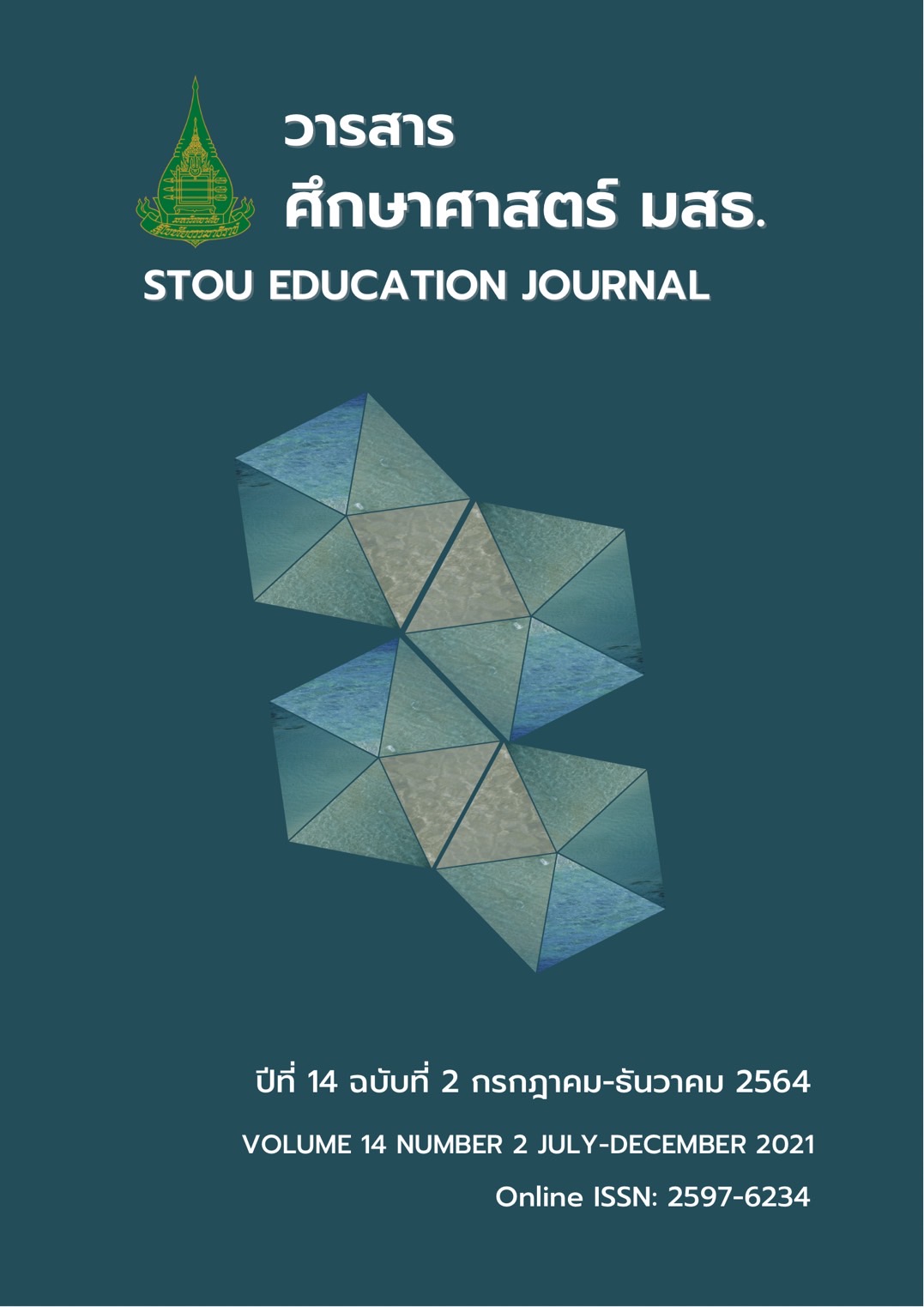การเปรียบเทียบผลสัมฤทธิ์ทางการเรียน เรื่อง สถิติ ของนักเรียนชั้นมัธยมศึกษาปีที่ 2 ระหว่างการเรียนแบบร่วมมือเทคนิค STAD กับการเรียนแบบปกติ
Main Article Content
บทคัดย่อ
การวิจัยนี้มีวัตถุประสงค์เพื่อเปรียบเทียบผลสัมฤทธิ์ทางการเรียนวิชาคณิตศาสตร์ เรื่อง สถิติ ของนักเรียนชั้นมัธยมศึกษาปีที่ 2 ที่ได้รับการจัดการเรียนการสอนแบบร่วมมือเทคนิค STAD กับการเรียนแบบปกติ และเปรียบเทียบผลสัมฤทธิ์ทางการเรียนวิชาคณิตศาสตร์ เรื่อง สถิติ ของนักเรียนชั้นมัธยมศึกษาปีที่ 2 ที่ได้รับการจัดการเรียนการสอนแบบร่วมมือเทคนิค STAD กับเกณฑ์ กลุ่มตัวอย่างที่ใช้ในการวิจัย คือ นักเรียนชั้นมัธยมศึกษาปีที่ 2 โรงเรียนศึกษาศาสตร์อิสลาม จังหวัดนราธิวาส ภาคเรียนที่ 2 ปีการศึกษา 2562 จํานวน 64 คน ได้มาโดยการสุ่มแบบกลุ่ม เครื่องมือที่ใช้ในการวิจัย ได้แก่ แผนการจัดการเรียนรู้แบบร่วมมือตามเทคนิค STAD แผนการจัดการเรียนรู้แบบปกติ และแบบทดสอบผลสัมฤทธิ์ทางการเรียน สถิติที่ใช้ในการวิเคราะห์ข้อมูล คือ ค่าเฉลี่ย ส่วนเบี่ยงเบนมาตรฐาน และการทดสอบค่าที ผลการวิจัย พบว่า ผลสัมฤทธิ์ทางการเรียนวิชาคณิตศาสตร์ เรื่อง สถิติ ของนักเรียนชั้นมัธยมศึกษาปีที่ 2 ที่ได้รับการจัดการเรียนการสอนแบบร่วมมือเทคนิค STAD สูงกว่าผลสัมฤทธิ์ทางการเรียนดังกล่าวของนักเรียนที่เรียนแบบปกติ อย่างมีนัยสำคัญทางสถิติที่ระดับ .01 และผลสัมฤทธิ์ทางการเรียนวิชาคณิตศาสตร์ เรื่อง สถิติ ของนักเรียนชั้นมัธยมศึกษาปีที่ 2 หลังจากได้รับการจัดการเรียนการสอนแบบร่วมมือเทคนิค STAD สูงกว่าเกณฑ์ร้อยละ 70 อย่างมีนัยสำคัญทางสถิติที่ระดับ .01
Article Details
เอกสารอ้างอิง
กระทรวงศึกษาธิการ. (2562, มกราคม 10). หลักสูตรแกนกลางการศึกษาขั้นพื้นฐาน พุทธศักราช 2551. สืบค้นจากhttp://academic.obec.go.th/newsdetail.php?id=75
ชนิกา ชาวงษ์. (2563). การศึกษาความสามารถในการให้เหตุผลเชิงสถิติโดยการใช้การจัดการเรียนรู้แบบร่วมมือ
ของนักเรียนชั้นมัธยมศึกษาปีที่4. (วิทยานิพนธ์ปริญญามหาบัณฑิต ไม่ได้ตีพิมพ์). มหาวิทยาลัย ศรีนครินทรวิโรฒ, กรุงเทพฯ.
ณัฏฐ์ชญา อินพูลวงษ์. (2559). ผลสัมฤทธิ์ทางการเรียนคณิตศาสตร์เจตคติต่อคณิตศาสตร์และพฤติกรรมการทำงานกลุ่มของนักเรียนชั้นประถมศึกษาปีที่ 6 ที่เรียนโดยการจัดการเรียนรู้แบบร่วมมือเทคนิคSTAD. (วิทยานิพนธ์ปริญญามหาบัณฑิต ไม่ได้ตีพิมพ์). มหาวิทยาลัยบูรพา, ชลบุรี.
พรรณภา อร่ามรุณ, โกมินทร์ บุญชู และ สวาท โชติ. (2560). การศึกษาผลสัมฤทธิ์ทางการเรียนวิชาคณิตศาสตร์ของนักเรียนชั้นมัธยมศึกษาปีที่ 2 โดยใช้การจัดการเรียนรู้แบบ STAD. สืบค้นจาก https://edu.kpru.ac.th/math//contents/research/6.pdf
ล้วน สายยศ และ อังคณา สายยศ. (2546). เทคนิคการวัดผลการเรียนรู้. กรุงเทพฯ: สุวีริยาสาสน์.
วัฒนาพร ระงับทุกข์. (2542). การเขียนแผนการสอนที่เน้นผู้เรียนเป็นศูนย์กลาง. กรุงเทพฯ: แอลทีเพรส.
สถาบันทดสอบทางการศึกษาแห่งชาติ (องค์การมหาชน). (2561). รายงานผลการทดสอบระดับชาติ ขั้นพื้นฐาน (O-NET) ปีการศึกษา 2561. สืบค้นจาก https://www.spm38.go.th/home/news/4128-o-net-2561.html
สถาบันส่งเสริมการสอนวิทยาศาสตร์และเทคโนโลยี. (2560). คู่มือการใช้หลักสูตรกลุ่มสาระคณิตศาสตร์ (ฉบับปรับปรุง 2560). สืบค้นจาก http://www.scimath.org/e-books/8380/8380.pdf
สุพัตรา คำหงษา, มะลิวัลย์ ถุนาพงศ์ และ นงลักษณ์ วิริยะพงศ์. (2558). การเปรียบเทียบผลสัมฤทธิ์ทางการเรียน เรื่องสมการเชิงเส้นตัวแปรเดียว ของนักเรียนชั้นมัธยมศึกษาปีที่ 1 ระหว่างการจัดการเรียนรู้แบบร่วมมือแบบ STAD กับการจัดการเรียนรู้แบบปกติ. วารสารการวัดผลทางการศึกษา มหาวิทยาลัยมหาสารคาม, 21(2), 369-381.
สุรีพร อนุศาสนนันท์. (2554). การวัดและการประเมินผลในชั้นเรียน. ชลบุรี: เก็ดกู๊ดครีเอชั่น.
เสาวณี แก้วสามสี. (2560). การเปรียบเทียบผลสัมฤทธิ์ทางการเรียนและเจตคติต่อวิชาคณิตศาสตร์ เรื่อง สมการเชิงเส้นตัวแปรเดียวของนักเรียนชั้นมัธยมศึกษาปีที่1ระหว่างการเรียนแบบร่วมมือเทคนิค STAD กับการเรียนแบบปกติ. (วิทยานิพนธ์ปริญญามหาบัณฑิต ไม่ได้ตีพิมพ์). มหาวิทยาลัยหาดใหญ่, สงขลา.


